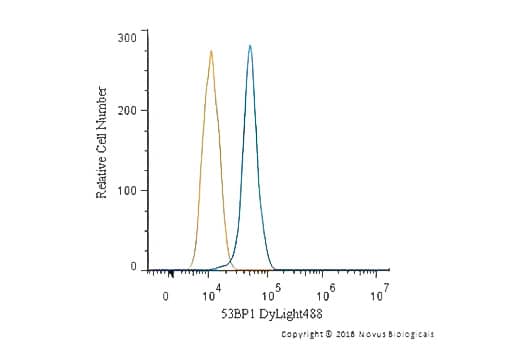Antibody conjugation involves tagging on a protein, compound or dye, in order to track its interaction with specific antigens. It is a routine procedure in immunoassays. At Bio-Techne, we have a vast number of products in our conjugated antibody catalog, to which we are constantly adding.
One of the most exciting developments of recent years has been tagging with fluorescent dyes, such as Alexa and DyLight fluor. For example, Beta-actin antibody conjugated to DyLight 549 is used in immunofluorescent assays, using a synthetic peptide conjugated to KLH (Keyhole Limpet Haemocyanin) as the immunogen.

Immunocytochemical analysis showing TGN46 expression in T98G glioblastoma cells using of Alexa Fluor® 488-conjugated Rabbit Anti-TGN46 Polyclonal Antibody (green; Catalog #NBP1-49643AF488) and tubulin (Alexa Fluor®594, red) with nuclei counterstained with DAPI (blue).
There are several DyLight products, categorized by a number which relates to the spectrum in which they absorb and emit light. DL 549 absorbs light at 562 nm and emits it at 576 nm. Dylight 549 labeled antibodies fluoresce with a yellow color. They are brighter and more stable than those conjugated with older dyes, such as rhodamine and Cy3. In addition, they maintain intense fluorescence over a wide range of pH values (from 4 to 9). Alexa fluor 546 works in a similar way.
Antibodies tagged with fluorescent dyes are used in a wide range of immunoassay techniques. These include flow cytometry (FACS), ELISA, Western blot and fluorescence microscopy.

Flow cytometry analysis showing An intracellular staining of Neuro2A cells using Rabbit Anti-53BP1 Polyclonal Antibody conjuagted to DyLight 488 (Catalog #NB100-304G) (blue) and a matched isotype control (orange).
We have a broad range of protocols for the conjugation of IgG proteins. These work extremely well for a variety of species and isotypes, including IgM. Some procedures work better than others. The cross-linking techniques used to conjugate the APC phycobiliprotein, for example, are resisted by some IgM antibodies. However, we are constantly striving to overcome tricky conjugates, in order to extend our comprehensive antibody database still further.